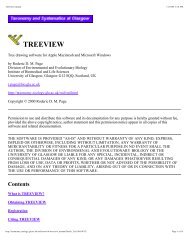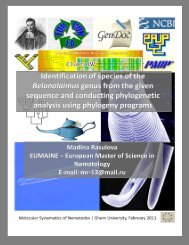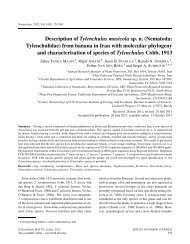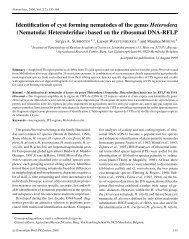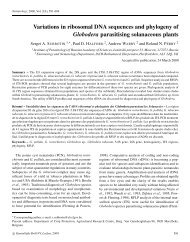Morphological and molecular characterisation of Californian species ...
Morphological and molecular characterisation of Californian species ...
Morphological and molecular characterisation of Californian species ...
You also want an ePaper? Increase the reach of your titles
YUMPU automatically turns print PDFs into web optimized ePapers that Google loves.
S. Álvarez-Ortega et al.<br />
<strong>species</strong> present the typical dorylaimoid two-layered pattern,<br />
they cannot be separated from the second group <strong>of</strong><br />
Aporcelaimellus forms.<br />
Lip region<br />
Metaporcelaimus: Nearly all the <strong>species</strong> <strong>of</strong> this genus<br />
have the lip region <strong>of</strong>fset from the adjacent body by a<br />
more or less (usually well) marked constriction. Independently<br />
<strong>of</strong> general body size, it is relatively narrow <strong>and</strong><br />
high, 14-21 μm broad <strong>and</strong> 5-6 μm high, i.e., 2.4-3.6 times<br />
as broad as high.<br />
Aporcelaimellus: The lip region is <strong>of</strong>fset by a (usually)<br />
deep constriction, although a few <strong>species</strong> show a weaker<br />
constriction or depression. Its breadth ranges from a<br />
minimum value <strong>of</strong> 11 (11-13 μm inA. heynsi Baqri &<br />
Jairajpuri, 1968) to a maximum <strong>of</strong> 28 (25-28 μm inA.<br />
malagasi), but most <strong>species</strong> lie between 15-20 μm. The<br />
height varies from 4 (4-6 μminA. waenga (Yeates, 1967)<br />
Peña-Santiago & Ciobanu, 2008) to 10 (7-10 μm inA.<br />
futaii Khan & Araki, 2002), but very <strong>of</strong>ten ranges between<br />
5 <strong>and</strong> 7 μm. It is 2.4-3.4 times as broad as high.<br />
There are no relevant differences between the genera<br />
regarding the morphology <strong>and</strong> morphometrics <strong>of</strong> the lip<br />
region: Aporcelaimellus <strong>species</strong> display a large variability<br />
which encompasses the ranges <strong>of</strong> Metaporcelaimus.<br />
Odontostyle aperture<br />
Metaporcelaimus: The odontostyle has a large aperture<br />
whose range varies from 50-80% <strong>and</strong> <strong>of</strong>ten forms twothirds<br />
to four-fifths <strong>of</strong> total odontostyle length.<br />
Aporcelaimellus: The aperture is also variable, ranging<br />
from 50 to 80% <strong>of</strong> total length, but very <strong>of</strong>ten occupies<br />
up to two-thirds <strong>of</strong> total length, exceeding this range in<br />
only a few <strong>species</strong> (A. gl<strong>and</strong>us Botha & Heyns, 1991, A.<br />
heynsi, A. insignis (Loos, 1945) Baqri & Khera, 1975,<br />
A. micropunctatus, A. punctatus Altherr in Altherr &<br />
Delamare-Deboutteville, 1972 <strong>and</strong> A. waenga).<br />
Although both genera display wide variation in this feature,<br />
in Metaporcelaimus <strong>species</strong> the odontostyle aperture<br />
is visibly longer than in Aporcelaimellus. However, there<br />
is a large overlap between the respective ranges, the reason<br />
why this is not a key diagnostic character for separating<br />
the taxa.<br />
Arrangement <strong>of</strong> S 1 N 1<br />
As mentioned above, the location <strong>of</strong> S 1 N 1 was the<br />
main argument for proposing Aporcelaimium (now a<br />
junior synonym <strong>of</strong> Metaporcelaimus) by Lo<strong>of</strong> & Coomans<br />
(1970) <strong>and</strong> to distinguish it from other aporcelaims,<br />
including Aporcelaimellus. Unfortunately, in the past not<br />
too much attention was paid to the detailed description<br />
<strong>of</strong> pharyngeal gl<strong>and</strong> nuclei <strong>and</strong>, hence, good data are<br />
available only for a limited number <strong>of</strong> <strong>species</strong>.<br />
Metaporcelaimus: S 1 N 1 is located posterior to the<br />
middle (55-65%) <strong>of</strong> the total neck length, closer to DN<br />
(6.5-11.5%) than to S 1 N 2 (12-14%).<br />
Aporcelaimellus: S 1 N 1 is located more posterior to the<br />
middle (59-76%) <strong>of</strong> the total neck length than in Metaporcelaimus,<br />
<strong>of</strong>ten closer to S 1 N 2 (4-12% <strong>of</strong> total neck<br />
length) than to DN (8-16.5% <strong>of</strong> total neck length); but<br />
also nearly equidistant to both DN <strong>and</strong> S 1 N 2 in a couple <strong>of</strong><br />
<strong>species</strong>: A. insularis (8% <strong>and</strong> 8.5%, respectively) <strong>and</strong> A.<br />
waenga (11 <strong>and</strong> 12); <strong>and</strong> even slightly closer to DN than<br />
to S 1 N 2 in a few other <strong>species</strong>: A. alius Andrássy, 2002b<br />
(10% <strong>and</strong> 11.5%, respectively), A. insignis (8.5 <strong>and</strong> 11.5),<br />
A. krygeri (8.5 <strong>and</strong> 10) A. medius Andrássy, 2002b (8.5<br />
<strong>and</strong> 10), <strong>and</strong> A. samarc<strong>and</strong>icus (Tulaganov, 1949) Baqri<br />
& Khera, 1975 (8.5 <strong>and</strong> 10).<br />
Taking into account the available information, there<br />
is no significant difference between the two genera,<br />
since, once again, Aporcelaimellus <strong>species</strong> display a wide<br />
variability that largely overlaps or embraces the known<br />
values for Metaporcelaimus <strong>species</strong>.<br />
Tail shape <strong>and</strong> size<br />
Metaporcelaimus: Although some variability is observed,<br />
mainly affecting morphometrics, the tail is conical<br />
with narrowly rounded tip, is straight ventrally <strong>and</strong> somewhat<br />
convex dorsally. It is 31-75 μm long <strong>and</strong> is always<br />
longer than the anal/cloacal body diam. (c ′ = 1.0-1.9),<br />
<strong>and</strong> occupies 1.5-2.9% <strong>of</strong> total body length. As mentioned<br />
above, the cuticle is typical dorylaimoid, <strong>and</strong> its inner core<br />
<strong>of</strong>ten becomes irregular or notched, ending near the tail<br />
tip, hence a hyaline portion is never distinguishable.<br />
Aporcelaimellus: Two patterns might be defined. Many<br />
<strong>species</strong> bear a convex conoid to rounded, even hemispherical,<br />
caudal region. Its length ranges from 15 to<br />
50 μm (exceptionally exceeding these limits in a few,<br />
large <strong>species</strong>), shorter than the anal/cloacal body diam.<br />
(c ′ = 0.2-1.1) except in two <strong>species</strong> (A. amylovorus<br />
(Thorne & Swanger, 1936) Heyns, 1965 <strong>and</strong> A. hylophilus<br />
Tjepkema, Ferris & Ferris, 1971) in which it is somewhat<br />
longer (c ′ = 1.0-1.3), <strong>and</strong> occupies 0.6-2.4% (very <strong>of</strong>ten<br />
less than 1.5%) <strong>of</strong> total body length. As mentioned too,<br />
the cuticle <strong>of</strong> the caudal region is typically three-layered,<br />
<strong>of</strong>ten with the intermediate layer well developed <strong>and</strong> the<br />
inner layer showing a more refractive appearance. The inner<br />
core is rather regular, not reaching the tail tip.<br />
An important group <strong>of</strong> conical-tailed <strong>species</strong> presents<br />
a similar pattern to that <strong>of</strong> Metaporcelaimus, i.e, conical<br />
14 Nematology



